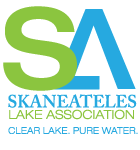ALERT: Harmful Algal Blooms (HABs) have been observed in the south eastern end of the lake. LEARN MORE
ALERT: Harmful Algal Blooms (HABs) have been observed in the south eastern end of the lake. LEARN MORE
Because it is hard to identify an algal bloom as harmful or non-harmful, it is best to avoid swimming, boating, otherwise recreating in, or drinking water with a bloom.
The following information is according to the New York State Department of Environmental Conservation (August 2020).[/vc_column_text][vc_column_text]
Most algae are harmless and are an important part of the food web. Certain types of algae can grow quickly and form blooms, which can cover all or portions of a lake. Even large blooms are not necessarily harmful. However some species of algae can produce toxins that can be harmful to people and animals. Blooms of algal species that can produce toxins are referred to as harmful algal blooms (HABs). HABs usually occur in nutrient-rich waters, particularly during hot, calm weather.
People, pets and livestock should avoid contact with any floating mats, scums, or discolored water. Colors can include shades of green, blue-green, yellow, brown or red.
Rinse thoroughly with clean water to remove algae.
Before you go in the water, find out what waterbodies have blooms or have had them in the past. DEC maintains a HABs Notifications page of waterbodies that currently have blooms. Please note that if a waterbody is not listed, it does not mean that it does not have a bloom. It may have one that was not reported. Find out what waterbodies have had blooms in the past on the HABs Archive page. For additional information, please see the DEC Program Guide (PDF), updated in 2019.
If you suspect that you have seen a HAB, please report the HAB to DEC.
Fill out and submit a Suspicious Algal Bloom Report Form (leaves DEC website). If possible, attach digital photos (close-up and landscape to show extent and location) of the suspected HAB in the web form. Email HABsInfo@dec.ny.gov if you are not able to complete the form.
Please report any health symptoms to NYS Health Department at harmfulalgae@health.ny.gov and your local health department (leaves DEC website)[/vc_column_text][/vc_column][/vc_row][vc_row row_type=”row” use_row_as_full_screen_section=”no” type=”full_width” text_align=”left” background_animation=”none” css_animation=””][vc_column][vc_column_text]Skaneateles Lake participates in the NYS Department of Environmental Conservation HAB Surveillance Program. Through the SLA over 35 residents have been trained in identifying and sampling HABs, are monitoring the lake weekly and coordinating response to reports of suspicious blooms from the public.
The NYSDEC archives recent HABs reported in New York state. Please click HERE to view the map. [/vc_column_text][vc_column_text]DEC site notification page: http://www.dec.ny.gov/chemical/83310.html
Learn More:
Frequently Asked Questions -NYSDOH
Blue-green Algae and Health – NYSDOH
Blue-Green Algae – Onondaga County Health Department
Skaneateles Lake Water Sample Test Results – NYSDOH
Blue-green Algae – Beach Operator Fact Sheet
Harmful Algal Bloom Notifications Page – NYSDEC
Cyanotoxins in Drinking Water – USEPA
Harmful Algal Blooms Photo Gallery – NYSDEC
Harmful algal bloom toxins key questions and answers – USEPA
Monitoring and Responding to Cyanobacteria and Cyanotoxins in Recreational Waters – USEPA
Recommendations for Public Water Systems to Manage Cyanotoxins in Drinking Water – USEPA
[/vc_column_text][/vc_column][/vc_row]
